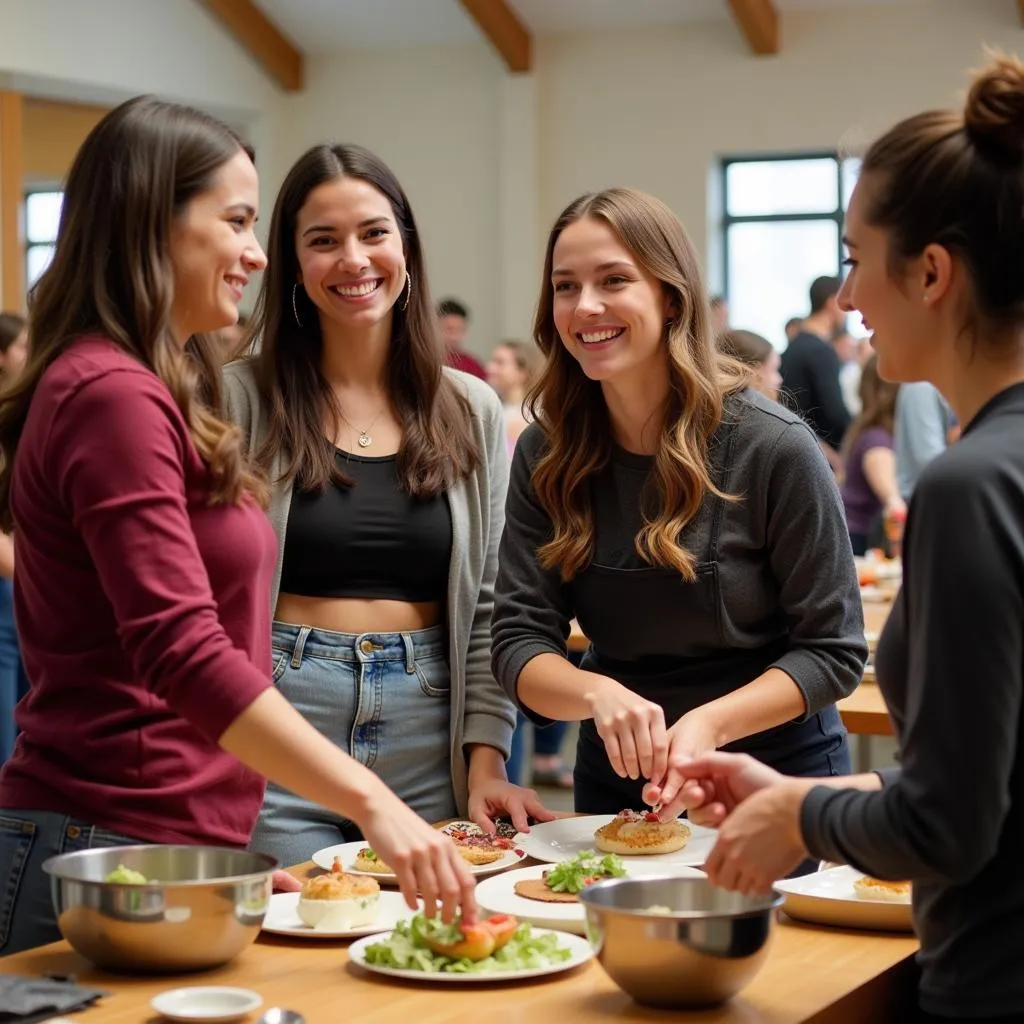The IELTS Reading test often explores diverse topics, and one fascinating subject that frequently appears is how culinary arts foster cultural appreciation. This article provides a comprehensive IELTS Reading practice test focused on this theme, offering valuable insights into the intersection of food and culture while honing your exam skills.
The integration of world cuisine in cultural education plays a crucial role in broadening our understanding of different societies. Let’s dive into a full IELTS Reading test that explores this concept in depth.
Passage 1 – Easy Text
The Global Kitchen: A Gateway to Cultural Understanding
In an increasingly interconnected world, the kitchen has become a powerful tool for cultural exchange and understanding. As people from diverse backgrounds share their culinary traditions, we gain invaluable insights into their history, values, and way of life. This phenomenon, often referred to as “culinary diplomacy,” has gained traction in recent years as a means of fostering cross-cultural appreciation and breaking down barriers between nations.
The act of preparing and sharing food is a universal language that transcends linguistic and cultural differences. When we taste a dish from another culture, we’re not just experiencing new flavors; we’re immersing ourselves in centuries of tradition, innovation, and social customs. For instance, the intricate spice blends of Indian cuisine reflect the country’s rich history of trade and cultural exchange, while the emphasis on fresh, seasonal ingredients in Japanese cooking speaks to the nation’s deep connection with nature.
Moreover, food has the power to evoke memories and emotions, making it an effective tool for cultural education. Many immigrants maintain connections to their heritage through traditional recipes passed down through generations. By sharing these dishes with others, they not only preserve their cultural identity but also introduce their host communities to new culinary experiences.
 People gathering at a community center event
People gathering at a community center event
How community centers contribute to cultural education is often exemplified through cooking classes and food festivals that bring people together to learn about different cuisines. These events provide a platform for cultural exchange, allowing participants to learn about the stories and traditions behind each dish.
In the realm of diplomacy, state dinners and culinary exchanges have long been used as a means of building rapport between nations. The choice of menu items, cooking techniques, and presentation styles can convey messages of respect, understanding, and shared values. This “gastrodiplomacy” has been embraced by countries such as Thailand and South Korea as a way to enhance their global image and promote cultural tourism.
As we continue to navigate an increasingly globalized world, the role of culinary arts in promoting cultural appreciation becomes ever more significant. By embracing the flavors, techniques, and traditions of diverse cuisines, we open ourselves to a deeper understanding of our global neighbors and cultivate a more inclusive and harmonious society.
Questions 1-5
Do the following statements agree with the information given in the passage? Write
TRUE if the statement agrees with the information
FALSE if the statement contradicts the information
NOT GIVEN if there is no information on this
- Culinary diplomacy is a new concept that has only emerged in the last few years.
- The spices used in Indian cuisine are a reflection of the country’s trading history.
- All immigrants successfully maintain their cultural identity through food.
- State dinners always include dishes from both host and guest countries.
- Thailand and South Korea use gastrodiplomacy to improve their international reputation.
Questions 6-10
Complete the sentences below. Choose NO MORE THAN TWO WORDS from the passage for each answer.
- The kitchen has become an effective tool for __ and understanding between cultures.
- Tasting a dish from another culture allows us to experience new flavors and __ ourselves in traditions.
- Food has the ability to __ and emotions, making it an effective tool for cultural education.
- Community centers often organize cooking classes and food festivals as a platform for __.
- The choice of menu items and cooking styles in diplomatic events can convey messages of respect and __.
Passage 2 – Medium Text
Culinary Education: Bridging Cultures Through Food
The integration of culinary arts into educational curricula has gained significant traction in recent years, as educators and policymakers recognize its potential to foster cultural appreciation and global understanding. This approach goes beyond merely teaching cooking techniques; it serves as a conduit for exploring history, geography, sociology, and even economics through the lens of food.
One of the primary benefits of culinary education is its ability to make abstract concepts tangible and relatable. For instance, studying the spice trade routes of the 15th and 16th centuries becomes more engaging when students can taste and smell the very spices that drove global exploration and colonization. Similarly, understanding the impact of climate change on agriculture takes on new significance when students learn about changing crop patterns and their effects on traditional cuisines.
 Map depicting historical spice trade routes
Map depicting historical spice trade routes
Moreover, culinary education provides a unique platform for cultural immersion. By learning to prepare dishes from various cultures, students gain insight into different value systems, social structures, and ways of life. For example, the communal nature of Mediterranean dining reflects the region’s emphasis on family and social bonds, while the precision and aesthetics of Japanese cuisine mirror the culture’s attention to detail and reverence for nature.
The role of education in promoting cultural heritage conservation is particularly evident in culinary programs that focus on traditional cooking methods and ingredients. These initiatives not only preserve culinary heritage but also promote sustainable food practices and support local economies.
Culinary education also plays a crucial role in challenging stereotypes and fostering empathy. When students learn about the origins and cultural significance of different foods, they develop a more nuanced understanding of other cultures. This understanding can help combat xenophobia and promote cultural sensitivity. For instance, learning about the rich variety of African cuisines can counteract monolithic perceptions of the continent and highlight its diverse culinary traditions.
Furthermore, culinary education can be a powerful tool for promoting social justice and addressing global issues. By exploring topics such as food security, sustainable agriculture, and fair trade practices, students develop a deeper understanding of global interconnectedness and their role as responsible global citizens. This awareness can inspire action and advocacy for more equitable and sustainable food systems.
The integration of technology in culinary education has opened up new avenues for cross-cultural exchange. Virtual cooking classes, online recipe sharing platforms, and food-focused social media have created global communities of food enthusiasts. These digital spaces allow for real-time cultural exchange and learning, transcending geographical boundaries and time zones.
As we continue to navigate an increasingly interconnected world, the role of culinary education in fostering cultural appreciation becomes ever more crucial. By embracing the power of food to educate, connect, and inspire, we can cultivate a more inclusive, empathetic, and globally aware society.
Questions 11-14
Choose the correct letter, A, B, C, or D.
- According to the passage, culinary education is valuable because it:
A) Focuses solely on teaching cooking techniques
B) Provides a way to explore various academic subjects
C) Is more important than traditional subjects
D) Guarantees job opportunities in the culinary industry
- The passage suggests that learning about spice trade routes becomes more engaging when students:
A) Read historical documents about trade
B) Visit countries involved in the spice trade
C) Can experience the spices with their senses
D) Write essays about global exploration
- How does culinary education help in challenging stereotypes?
A) By prohibiting the discussion of cultural differences
B) By focusing only on Western cuisines
C) By promoting a single global cuisine
D) By providing insight into the diversity of cultural food traditions
- According to the passage, how has technology impacted culinary education?
A) It has made traditional cooking methods obsolete
B) It has limited the exchange of culinary knowledge
C) It has created new opportunities for global cultural exchange
D) It has reduced the need for hands-on cooking experiences
Questions 15-19
Complete the summary below. Choose NO MORE THAN TWO WORDS from the passage for each answer.
Culinary education offers numerous benefits beyond teaching cooking skills. It helps make (15) __ concepts more relatable and provides a platform for (16) __. By learning about different cuisines, students gain insights into various (17) __ and ways of life. This approach also aids in (18) __ and fostering empathy. Additionally, culinary education can be used to promote (19) __ and address global issues related to food and agriculture.
Passage 3 – Hard Text
The Anthropology of Cuisine: Unraveling Cultural Identities Through Food
The study of food as a lens through which to examine culture has gained significant traction in anthropological circles over the past few decades. This burgeoning field, often referred to as “culinary anthropology” or “food anthropology,” posits that the gastronomic practices of a society are inextricably linked to its cultural, social, and economic structures. By analyzing the ingredients, preparation methods, consumption rituals, and symbolic meanings associated with food, anthropologists can gain profound insights into the collective psyche of a community and trace the evolution of its cultural identity.
One of the fundamental premises of culinary anthropology is that food serves as a semiotic system, a set of signs and symbols that communicate cultural values and beliefs. For instance, the kosher dietary laws in Judaism not only dictate what can be eaten but also reflect deeper spiritual and ethical principles. Similarly, the elaborate tea ceremonies in Japan are not merely about consuming a beverage but embody concepts of harmony, respect, purity, and tranquility that are central to Japanese aesthetics and philosophy.
 A traditional Japanese tea ceremony
A traditional Japanese tea ceremony
The globalization of food culture presents both opportunities and challenges for culinary anthropologists. On one hand, the increased accessibility of diverse cuisines has facilitated cross-cultural understanding and appreciation. On the other hand, it has led to the homogenization of food cultures, potentially eroding local culinary traditions. This phenomenon, often termed “culinary imperialism,” raises questions about authenticity, cultural appropriation, and the power dynamics inherent in global food systems.
Effects of global connectivity on culture are particularly evident in the realm of cuisine, where fusion dishes and adapted recipes reflect the complex interplay between tradition and innovation. Anthropologists study these culinary hybrids as manifestations of cultural negotiation and adaptation in an increasingly interconnected world.
The concept of “culinary heritage” has emerged as a crucial area of study within food anthropology. UNESCO’s recognition of certain cuisines as Intangible Cultural Heritage underscores the importance of preserving traditional foodways. However, this approach has been critiqued for potentially essentializing cultures and overlooking the dynamic, ever-evolving nature of culinary traditions. Anthropologists grapple with the challenge of balancing preservation efforts with the acknowledgment of cuisine as a living, adapting entity.
Food anthropologists also explore the role of cuisine in constructing and maintaining social hierarchies. The concept of “culinary capital,” derived from Pierre Bourdieu’s theory of cultural capital, suggests that knowledge about and access to certain foods can be a marker of social status. This perspective provides valuable insights into how food choices reflect and reinforce class distinctions, ethnic identities, and gender roles within a society.
The study of food taboos and preferences offers another rich vein of anthropological inquiry. These cultural norms around food often reveal deep-seated beliefs about purity, contamination, and the human-nature relationship. For example, the avoidance of pork in some cultures may be rooted in historical, environmental, or religious factors, each providing a window into the society’s worldview and adaptive strategies.
Culinary anthropology also intersects with critical issues of food security, sustainability, and social justice. By examining traditional food systems and agricultural practices, anthropologists contribute to debates on biodiversity conservation, climate change adaptation, and the rights of indigenous communities. This applied dimension of food anthropology demonstrates its relevance to contemporary global challenges.
As the field of culinary anthropology continues to evolve, it increasingly incorporates interdisciplinary approaches, drawing on insights from nutrition science, environmental studies, and cultural geography. This holistic perspective allows for a more nuanced understanding of the complex relationships between food, culture, and identity in our rapidly changing world.
In conclusion, the anthropology of cuisine offers a unique and valuable approach to understanding cultural identities. By recognizing food as a powerful cultural symbol and social practice, we gain deeper insights into the complexities of human societies and the forces that shape them. As we navigate the challenges of globalization and cultural change, the lessons gleaned from culinary anthropology can guide us towards more inclusive, sustainable, and culturally sensitive approaches to food and identity.
Questions 20-23
Choose the correct letter, A, B, C, or D.
- According to the passage, culinary anthropology is based on the idea that:
A) All cultures have similar food practices
B) Food practices are separate from cultural structures
C) Gastronomic practices are closely tied to cultural structures
D) Studying food is less important than studying language
- The passage suggests that globalization of food culture has:
A) Only positive effects on local cuisines
B) No impact on local food traditions
C) Both positive and negative impacts on food cultures
D) Completely eliminated local culinary practices
- The concept of “culinary capital” suggests that:
A) All foods have equal social value
B) Knowledge about certain foods can indicate social status
C) Only expensive foods have cultural significance
D) Food choices are irrelevant to social hierarchies
- According to the passage, the study of food taboos:
A) Is unrelated to cultural beliefs
B) Only focuses on religious practices
C) Reveals insights into a society’s worldview
D) Is no longer relevant in modern anthropology
Questions 24-26
Complete the sentences below. Choose NO MORE THAN TWO WORDS from the passage for each answer.
-
The recognition of certain cuisines as Intangible Cultural Heritage by UNESCO highlights the importance of preserving traditional __.
-
Food anthropologists face the challenge of balancing preservation efforts with the recognition of cuisine as a __, adapting entity.
-
The anthropology of cuisine incorporates interdisciplinary approaches, including insights from nutrition science, environmental studies, and __.
Questions 27-30
Do the following statements agree with the information given in the passage? Write
TRUE if the statement agrees with the information
FALSE if the statement contradicts the information
NOT GIVEN if there is no information on this
-
Culinary anthropology is a well-established field that has been studied for centuries.
-
The Japanese tea ceremony reflects important concepts in Japanese philosophy.
-
UNESCO’s recognition of cuisines as Intangible Cultural Heritage is universally accepted without criticism.
-
Culinary anthropology has no practical applications in addressing contemporary global challenges.
Answer Key
Passage 1
- FALSE
- TRUE
- NOT GIVEN
- NOT GIVEN
- TRUE
- cultural exchange
- immerse
- evoke memories
- cultural exchange
- shared values
Passage 2
- B
- C
- D
- C
- abstract
- cultural immersion
- value systems
- challenging stereotypes
- social justice
Passage 3
- C
- C
- B
- C
- foodways
- living
- cultural geography
- FALSE
- TRUE
- FALSE
- FALSE
This IELTS Reading practice test explores the fascinating intersection of culinary arts and cultural appreciation. By engaging with these passages and questions, you’ve not only honed your reading skills but also gained valuable insights into how food serves as a powerful medium for cultural understanding and exchange. Remember to apply the strategies you’ve practiced here in your actual IELTS exam, such as careful reading, identifying key information, and managing your time effectively across all three passages.


